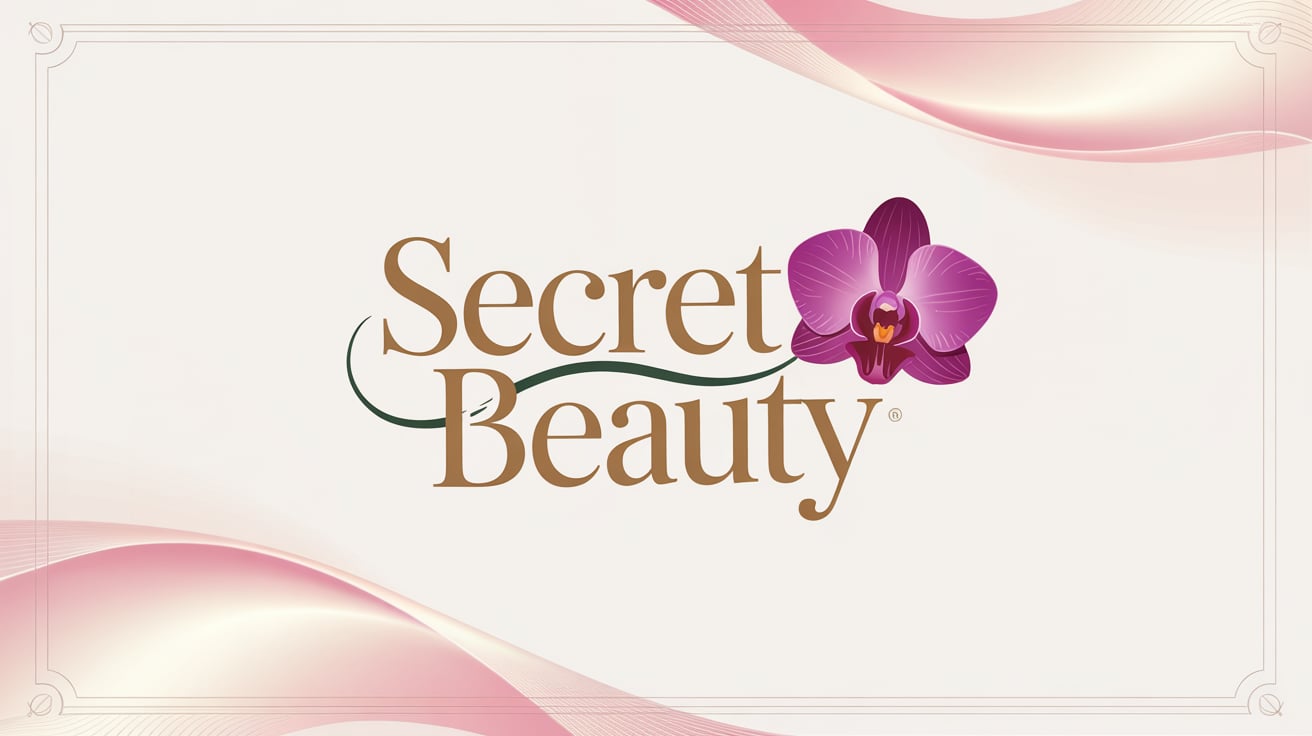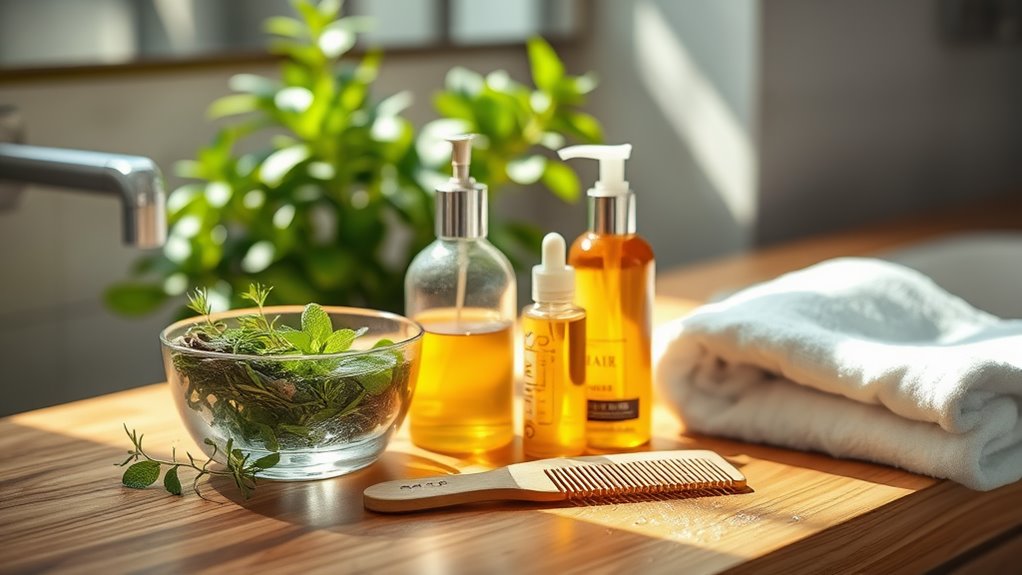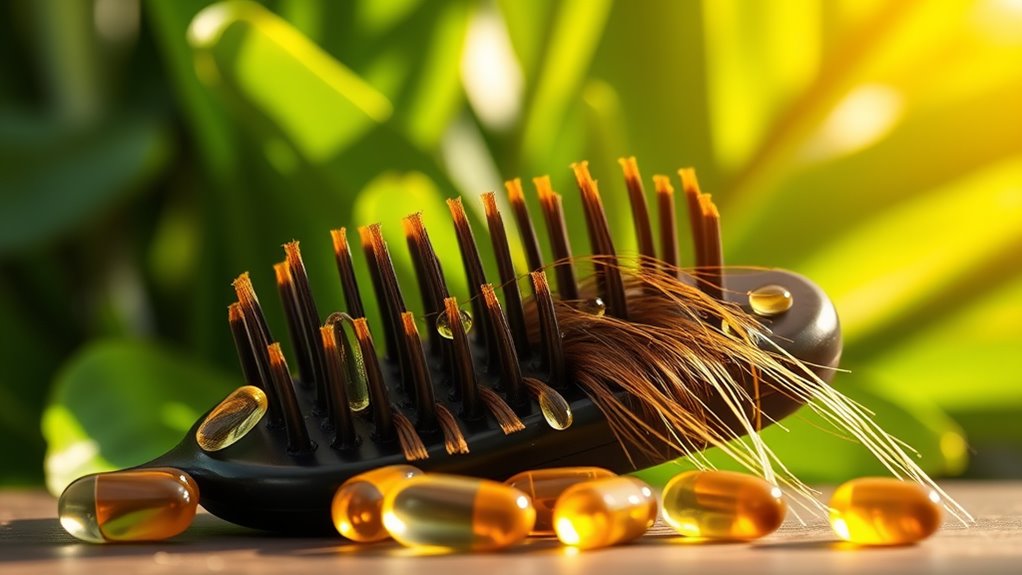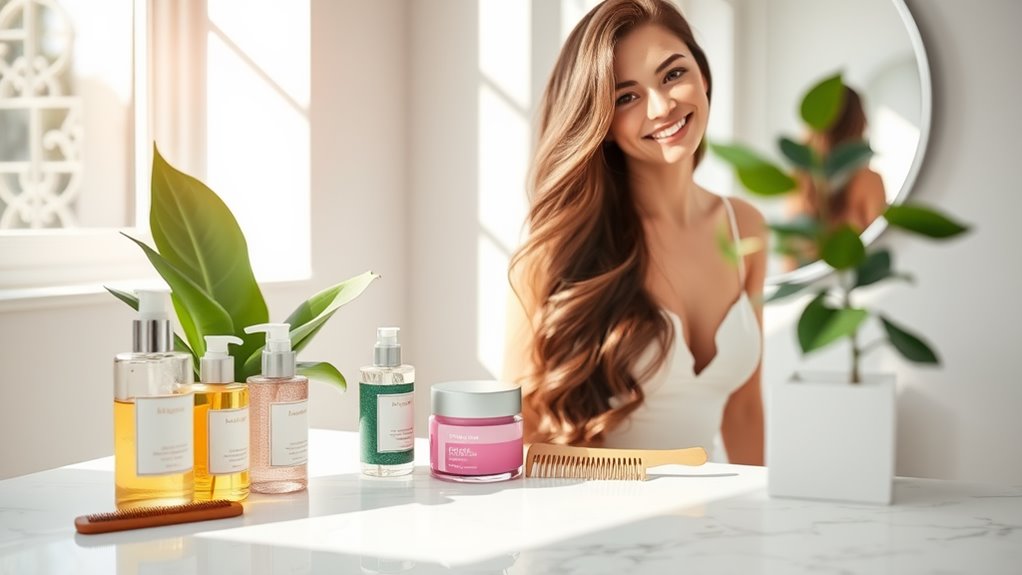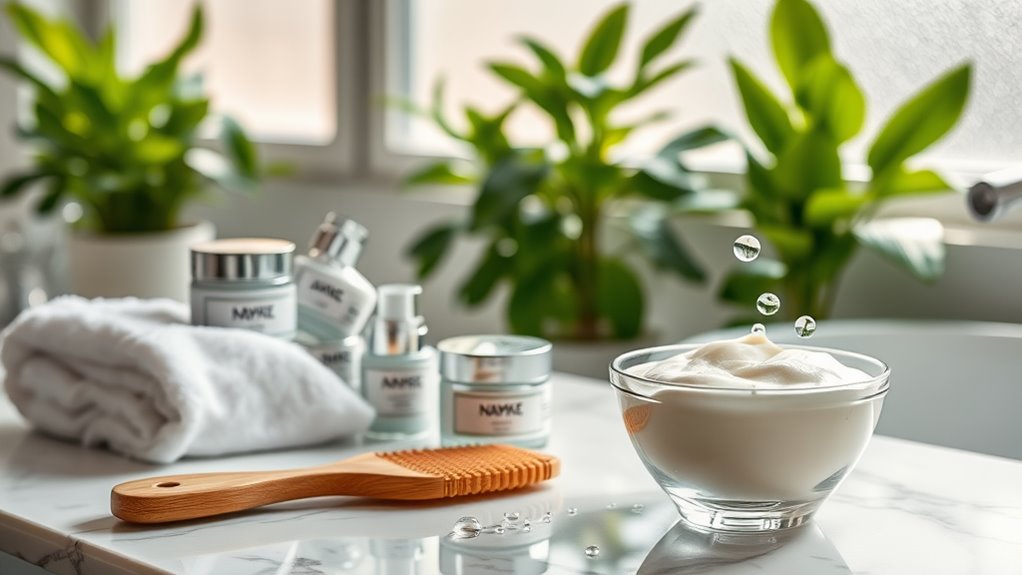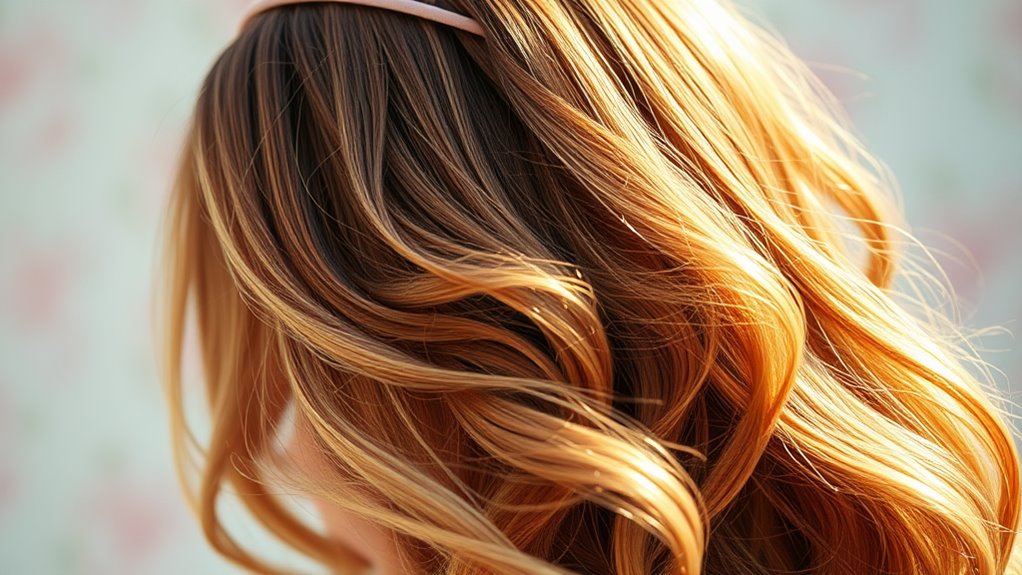Easy Scalp Routine That Encourages Hair Growth
To encourage hair growth, start with daily cleansing using a gentle, sulfate-free shampoo, massaging it into your scalp to boost circulation. Exfoliate weekly to remove buildup and enhance nutrient delivery. Incorporate a relaxing scalp massage for at least five minutes each day, using essential oils like rosemary or peppermint for added nourishment. Don’t forget to hydrate your scalp and eat nutrient-rich foods like leafy greens and nuts. There’s more to explore for ideal scalp health.
Key Takeaways
- Use a gentle, sulfate-free shampoo to cleanse your scalp daily or every other day, promoting a healthy environment for hair growth.
- Exfoliate your scalp weekly to remove dead skin cells and excess oil, enhancing circulation and nutrient delivery to hair follicles.
- Incorporate a daily scalp massage for five minutes to boost blood flow and relaxation, supporting hair growth and overall scalp health.
- Select lightweight, moisturizing hair products tailored to your scalp’s needs, ensuring optimal hydration without weighing hair down.
- Maintain a balanced diet rich in leafy greens, lean proteins, and healthy fats to nourish your scalp and encourage robust hair growth.
Understanding the Importance of Scalp Health
Your scalp is the foundation for healthy hair growth, and neglecting it can hinder your efforts. Proper scalp care isn’t just a luxury; it’s crucial for creating an ideal environment for hair follicles.
When you prioritize your scalp’s health, you promote circulation, balance oil production, and reduce the risk of dandruff and irritation.
Incorporate regular exfoliation to remove dead skin cells and product buildup, allowing your follicles to breathe. Nourishing your scalp with targeted treatments can enhance nutrient absorption, further supporting hair growth. Additionally, ensuring a comprehensive scalp care routine can significantly improve the overall health of your hair.
Don’t overlook the psychological benefits of a healthy scalp; it can boost your confidence and overall well-being. By mastering your scalp care routine, you’re investing in the strength, shine, and health of your hair.
Daily Cleansing Techniques for a Healthy Scalp
To maintain a healthy scalp, daily cleansing is essential for removing dirt, excess oil, and product buildup.
Start by selecting a gentle, sulfate-free shampoo that suits your hair type. Applying it directly to your scalp, use your fingertips—never your nails—to massage the shampoo in circular motions. This encourages blood flow while effectively cleansing the scalp.
Rinse thoroughly and follow with a lightweight conditioner, applying it only to the ends of your hair to avoid weighing down your roots.
Try to wash your hair every day or every other day, depending on your scalp’s oiliness. Remember, consistency is key. Additionally, incorporating essential nutrients like biotin and omega-3 fatty acids can further support your hair growth journey.
Exfoliation: Removing Build-Up for Hair Growth
Exfoliating your scalp is essential for promoting hair growth and keeping your scalp healthy. By removing build-up, you allow your hair follicles to breathe and absorb nutrients better. Regular scalp exfoliation can also help improve blood circulation, which is crucial for healthy hair growth. Let’s explore the best techniques and products to achieve a refreshed scalp.
Importance of Scalp Exfoliation
While many focus on nourishing hair with products, the health of your scalp plays an essential role in promoting hair growth. Scalp exfoliation is vital for removing dead skin cells, excess oil, and product buildup that can suffocate hair follicles.
When you exfoliate, you stimulate circulation, enhancing nutrient delivery to the roots, which fosters healthier hair growth. A clean scalp reduces the risk of dandruff and irritation, creating an ideal environment for hair to thrive.
Additionally, regular exfoliation can help balance your scalp’s natural oils, preventing greasiness or dryness. By incorporating scalp exfoliation into your routine, you’re not just addressing existing issues but actively cultivating a foundation for robust hair growth.
Prioritize this step for lasting results.
Best Exfoliation Techniques
How can you effectively remove buildup and promote hair growth? Start by implementing these exfoliation techniques. Regular exfoliation clears away dead skin cells, excess oil, and product residue, ensuring your scalp stays healthy. Here are some effective methods:
| Technique | Benefits |
|---|---|
| Physical Exfoliation | Removes buildup manually |
| Chemical Exfoliation | Deep cleans pores |
| Scalp Massages | Stimulates blood circulation |
| DIY Scrubs | Customizable and natural |
Incorporate these techniques into your routine, and you’ll notice improved scalp health and increased hair growth. Consistency is key; aim for exfoliation once a week to maintain ideal results. Your scalp deserves the best, so invest the time and effort for thriving hair!
Recommended Products to Use
To achieve the best results in removing buildup and promoting hair growth, selecting the right products is essential.
Using the right exfoliating products can transform your scalp health and support vibrant hair growth. Here are three must-have items you should consider:
-
Scalp Scrub – A targeted scrub with natural exfoliants can remove dead skin and excess oil, invigorating your scalp.
-
Clarifying Shampoo – This product deep-cleanses your hair, eliminating stubborn buildup without stripping moisture.
-
Scalp Oil – Look for nourishing oils infused with essential nutrients to hydrate and soothe your scalp after exfoliation.
Incorporating these products into your routine will empower you to master the art of scalp care and unleash your hair’s full potential.
Scalp Massage: Boosting Circulation and Relaxation
When you incorporate scalp massages into your hair care routine, you can greatly boost circulation and promote relaxation. This simple yet effective technique enhances blood flow to hair follicles, delivering essential nutrients and oxygen necessary for ideal growth. Additionally, regular scalp stimulation can revitalize your hair and improve overall scalp health.
To perform a scalp massage, use your fingertips to apply gentle pressure in circular motions, focusing on areas that feel tense. Aim for at least five minutes daily, allowing tension to melt away while stimulating your scalp.
You can also vary your technique by incorporating tapping or kneading movements to further invigorate the scalp. Regular practice not only encourages hair growth but also reduces stress, creating a holistic approach to your hair health.
Enjoy the soothing benefits and watch your hair thrive!
Essential Oils for Scalp Nourishment
As you explore ways to nourish your scalp, essential oils can offer a powerful boost to your hair growth routine.
These nature-derived wonders not only stimulate hair follicles but also enhance your overall scalp health. Incorporating dietary changes that support hair growth can further amplify the benefits of these essential oils.
Here are three essential oils to take into account:
-
Rosemary Oil: Known for its ability to improve circulation, it helps promote hair growth and combat thinning.
-
Peppermint Oil: This invigorating oil increases blood flow, creating a revitalizing sensation that rejuvenates your scalp.
-
Lavender Oil: Renowned for its calming properties, it can reduce stress and encourage a healthy environment for hair growth.
Incorporate these oils into your routine, and watch as your scalp flourishes, leading to stronger and healthier hair over time.
Choosing the Right Hair Products for Your Scalp
Finding the right hair products for your scalp is essential for promoting healthy hair growth. Start by selecting shampoos and conditioners formulated specifically for your scalp type—whether it’s oily, dry, or sensitive.
Look for sulfate-free options that cleanse without stripping natural oils. Incorporate products enriched with nourishing ingredients like tea tree oil or salicylic acid, which can help maintain a balanced environment on your scalp.
Avoid heavy silicones that may clog pores and impede hair growth. When choosing styling products, opt for lightweight formulas that don’t weigh your hair down.
Always check for any potential allergens and make adjustments based on how your scalp reacts. Tailoring your product selection to your unique needs will foster an ideal environment for hair growth.
Hydration and Moisturization: Keeping Your Scalp Balanced
Keeping your scalp hydrated is essential for promoting healthy hair growth.
You’ll want to focus on the finest moisturizing ingredients and effective hydration techniques to maintain balance.
Let’s explore how to achieve a well-hydrated scalp for ideal results.
Importance of Scalp Hydration
Although many focus on the hair itself, the health of your scalp is just as important for promoting hair growth.
When your scalp is well-hydrated, it creates an ideal environment for hair follicles to thrive.
Here are three reasons why scalp hydration matters:
-
Prevents Dryness: A hydrated scalp reduces flakiness and irritation, making it more comfortable and less prone to conditions like dandruff.
-
Boosts Blood Circulation: Adequate moisture encourages better blood flow, delivering crucial nutrients to hair follicles.
-
Enhances Hair Strength: A balanced scalp promotes stronger hair, reducing breakage and ensuring a fuller appearance.
Investing in scalp hydration isn’t just a beauty routine; it’s a commitment to nurturing your hair from the roots up.
Best Moisturizing Ingredients
When it comes to maintaining a healthy scalp, choosing the right moisturizing ingredients is essential for achieving effective hydration.
Look for ingredients like hyaluronic acid, which retains moisture and plumps the skin, and aloe vera, known for its soothing and hydrating properties.
Coconut oil is another powerhouse; it penetrates deeply and nourishes both scalp and hair.
Glycerin attracts moisture from the environment, ensuring your scalp stays hydrated.
Additionally, shea butter provides a protective barrier while locking in moisture.
Don’t overlook jojoba oil, as it mimics your scalp’s natural sebum, promoting balance.
By incorporating these ingredients into your routine, you’ll create an ideal environment for hair growth and maintain a well-hydrated scalp.
Choose wisely to achieve mastery in scalp care.
Hydration Techniques and Tips
To maintain a well-hydrated scalp, it’s important to adopt effective hydration techniques that complement your choice of moisturizing ingredients. Here are three essential tips to elevate your scalp care routine:
-
Hydrate Internally: Drink plenty of water daily. Your scalp needs hydration from within to support hair growth and maintain balance.
-
Use a Humidifier****: If your environment’s dry, a humidifier can add moisture to the air, preventing your scalp from becoming dry and flaky.
-
Weekly Scalp Masks: Incorporate hydrating masks with natural oils or aloe vera. This not only nourishes your scalp but also promotes a healthy foundation for hair growth.
Nutrition: Foods That Support Scalp and Hair Health
A balanced diet plays an essential role in promoting scalp and hair health. To fuel your hair growth, focus on foods rich in vitamins and minerals.
Incorporate leafy greens, like spinach and kale, for their high iron content, which boosts circulation to the scalp. Protein is important, so include lean meats, eggs, and legumes to support keratin production.
Don’t overlook healthy fats; avocados and nuts provide omega-3 fatty acids, necessary for hydration and shine. Berries pack antioxidants that protect hair follicles from damage.
Finally, consider adding sweet potatoes for their beta-carotene, which converts to vitamin A, fostering a healthier scalp.
Lifestyle Habits That Promote Scalp Wellness
Although it might seem simple, adopting consistent lifestyle habits can greatly enhance your scalp wellness and, in turn, promote hair growth.
Mastering these habits will empower you to take control of your scalp health.
-
Stay Hydrated: Drinking enough water keeps your scalp hydrated, supporting its natural functions and overall health.
-
Manage Stress: Practicing mindfulness or engaging in regular exercise reduces stress, which can negatively impact hair growth.
-
Prioritize Sleep: Quality sleep fosters cellular repair and rejuvenation, allowing your scalp and hair follicles to thrive.
Incorporating these habits into your daily routine won’t only transform your scalp health but also instill a sense of mastery over your hair growth journey.
Embrace these principles, and watch your hair flourish!
Monitoring Your Scalp’s Condition for Optimal Growth
To achieve ideal hair growth, you need to keep a close eye on your scalp’s condition.
By recognizing key scalp health indicators and using regular monitoring techniques, you can effectively track your progress.
This proactive approach will help you adjust your routine for the best possible results.
Scalp Health Indicators
How can you tell if your scalp is thriving or struggling? Recognizing the signs can guide you toward ideal hair growth. Pay attention to these key indicators:
-
Flaking or Itching: If your scalp feels itchy or shows flakes, it may signal dryness or irritation, hindering growth.
-
Excess Oiliness: A greasy scalp can indicate overactive sebaceous glands, which may lead to clogged follicles and hair loss.
-
Hair Thinning: Noticeable thinning or bald patches could suggest a lack of nutrients or stress, both detrimental to hair health.
Regular Monitoring Techniques
Are you keeping a close eye on your scalp’s condition? Regular monitoring is key to maximizing hair growth. Start by examining your scalp weekly for changes in texture, color, or any signs of irritation.
Use a journal to document your observations, noting any fluctuations in oiliness or dryness. Pay attention to hair shedding; a sudden increase might signal underlying issues.
Implement a routine that includes gentle scalp massages to enhance blood circulation and promote awareness of your scalp’s health. Additionally, consider taking photos to track visual changes over time.
Frequently Asked Questions
How Often Should I Exfoliate My Scalp?
You should exfoliate your scalp once every two weeks. This frequency helps remove buildup and promotes a healthier environment for hair growth. Adjust based on your scalp’s sensitivity and any specific needs you notice.
Can Stress Affect My Scalp Health?
Absolutely, stress impacts your scalp health. It can lead to inflammation, dryness, and even hair loss. By managing stress through techniques like mindfulness or exercise, you can promote a healthier scalp environment for your hair.
What Ingredients Should I Avoid in Hair Products?
You should avoid sulfates, parabens, and alcohol in hair products. These ingredients can strip moisture, irritate your scalp, and weaken hair. Opt for gentle, nourishing alternatives to maintain a healthy, thriving scalp environment.
Is It Okay to Use Heat Tools on My Hair?
Using heat tools isn’t inherently bad, but you should minimize their use. Always apply a heat protectant, adjust the temperature to your hair type, and give your locks a break to maintain their health.
How Long Before I See Results From My Scalp Routine?
You’ll typically notice results from your scalp routine within four to eight weeks, depending on your hair’s health and the consistency of your efforts. Stay committed, and you’ll likely see significant improvements soon.
